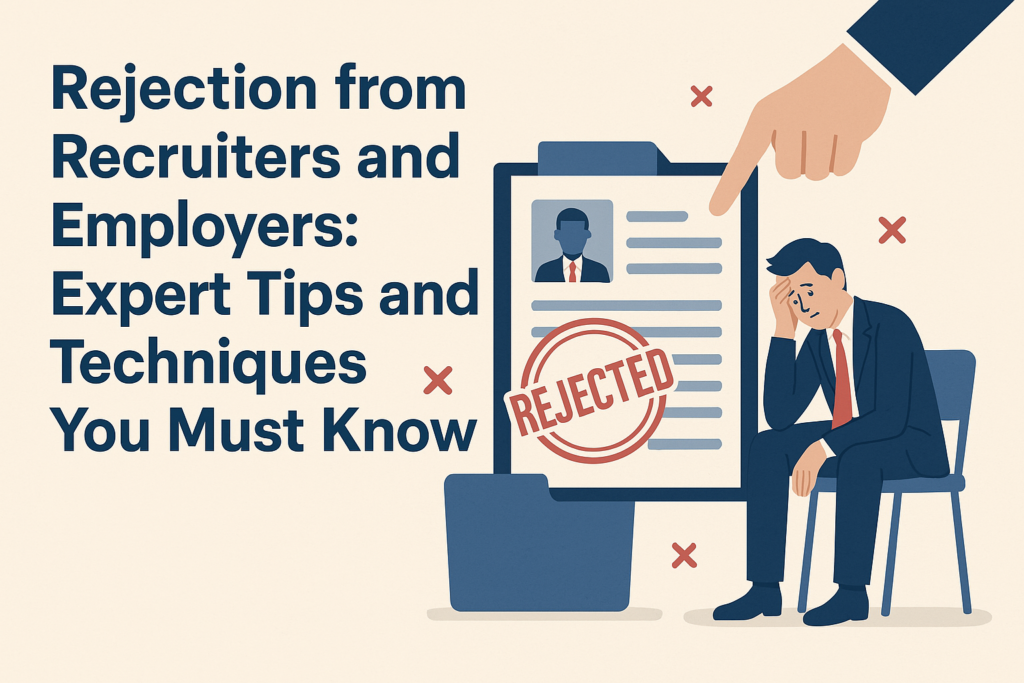Rejection is an inevitable part of the job search process. Whether you’re a recent graduate, a seasoned professional, or someone transitioning careers, facing rejection from recruiters and employers can be disheartening.
However, how you handle rejection can make all the difference in your career journey. This article will guide you through practical steps to cope with rejection, learn from it, and ultimately turn it into a stepping stone for success.
Why Rejection Happens
Before diving into how to handle rejection, it’s important to understand why it happens. Rejection doesn’t always mean you’re unqualified or unfit for the role. Here are some common reasons why recruiters and employers might reject candidates:
1. Poorly composed CV and application form: Research suggests that recruiters spend less than 10 seconds looking at applicant’s CV before passing through the first screen. Thus, investment into your application documents cannot be overemphasised.
2. Bias in recruitment: Certain applicants’ application forms and CVs are susceptible to bias, so also interviews. This means hiring managers and recruiters need a bit of education and enlightenment on the benefits of hiring diverse talents. The Harvard Business Review founds if there’s only one woman in your candidate pool, there’s statistically no chance she’ll be hired.
3. Intense Competition: Many job openings attract hundreds of applicants, making it difficult for recruiters to choose just one candidate.
4. Cultural Fit: Employers often look for candidates who align with their company culture, which isn’t always about skills or experience.
5. Overqualified or Underqualified: Sometimes, your qualifications may not match the specific requirements of the role.
6. Timing: The company might have already found a suitable candidate before your application was reviewed.
7. Internal Changes: Budget cuts, hiring freezes, or shifts in company priorities can lead to rejections.
Understanding these reasons can help you put rejection into perspective and avoid taking it personally.
Below are steps that can help you handle rejections.
Step 1: Acknowledge Your Emotions
Rejection can trigger a range of emotions, from disappointment and frustration to self-doubt. It’s important to acknowledge these feelings rather than suppress them. Here’s how:
– Allow Yourself to Feel: Give yourself permission to feel upset. It’s okay to be disappointed—it shows you care about your career.
– Talk to Someone: Share your feelings with a trusted friend, family member, or mentor. Sometimes, just talking about it can provide relief.
– Avoid Negative Self-Talk: Don’t let rejection define your self-worth. Remind yourself that one rejection doesn’t mean you’re not capable or talented.
Step 2: Reflect on the Experience
Once you’ve processed your emotions, take a step back and reflect on the experience. This is where growth happens. Ask yourself:
– What Can I Learn?: Were there any gaps in your resume, interview skills, or qualifications that you can improve?
– Was It the Right Fit?: Sometimes, rejection is a blessing in disguise. Reflect on whether the role and company truly aligned with your career goals.
– What Feedback Did I Receive?: If the recruiter or employer-provided feedback, take it constructively. Use it to refine your approach.
Step 3: Seek Feedback (If Possible)
While not all recruiters or employers provide feedback, it doesn’t hurt to ask. A polite email requesting constructive feedback can provide valuable insights. Here’s how to ask:
– Be Polite and Professional: Thank them for the opportunity and express your interest in improving.
– Keep It Brief: Don’t overwhelm them with questions. A simple request for feedback is enough.
Example Email:
“`
Subject: Request for Feedback on My Application
Dear [Recruiter’s Name],
Thank you for considering my application for the [Job Title] position. While I’m disappointed I wasn’t selected, I’m eager to learn and improve. If you have any feedback on my application or interview, I would greatly appreciate it.
Thank you again for your time and consideration.
Best regards,
[Your Name]
“`
Step 4: Improve Your Job Search Strategy
Rejection is an opportunity to refine your job search strategy. Here are some actionable tips:
Tailor Your Resume and Cover Letter:
– Customize your resume and cover letter for each job application. Highlight relevant skills and experiences that match the job description.
– Use keywords from the job posting to pass Applicant Tracking Systems (ATS).
Enhance Your Skills:
– Identify any skills gaps and take online courses, attend workshops, or earn certifications to strengthen your profile.
– Platforms like Coursera, LinkedIn Learning, and Udemy offer affordable courses in various fields.
Practice Interview Skills:
– Rehearse common interview questions and practice your responses with a friend or mentor.
– Record yourself to identify areas for improvement, such as body language or tone of voice.
Expand Your Network:
– Networking can open doors to opportunities that aren’t advertised. Attend industry events, join professional groups, and connect with people on LinkedIn.
– Don’t hesitate to reach out to alumni or professionals in your desired field for informational interviews.
Step 5: Stay Positive and Persistent
A positive mindset is crucial when dealing with rejection. Here’s how to stay motivated:
– Set Realistic Goals: Break your job search into smaller, manageable tasks, such as applying to a certain number of jobs per week.
– Celebrate Small Wins: Acknowledge progress, whether it’s a successful networking connection or a well-crafted application.
– Stay Consistent: Job searching can be a marathon, not a sprint. Stay consistent and don’t give up.
Step 6: Consider Alternative Opportunities
If you’re facing repeated rejections, it might be time to explore alternative opportunities:
– Freelancing or Contract Work: These roles can help you gain experience and build your portfolio.
– Internships or Volunteer Work: These opportunities can provide valuable experience and help you network.
– Career Pivots: If your current field isn’t working out, consider transitioning to a related industry or role.
Step 7: Learn from Success Stories
Many successful people have faced rejection before achieving their goals. For example:
– J.K. Rowling: The author of the Harry Potter series was rejected by multiple publishers before finding success.
– Steve Jobs: The co-founder of Apple was fired from his own company before making a triumphant return.
– Oprah Winfrey: She was told she wasn’t fit for television but went on to become a media mogul.
These stories remind us that rejection is not the end—it’s often the beginning of something greater.
Step 8: Know When to Take a Break
Job searching can be exhausting, both mentally and emotionally. If you’re feeling burnt out, it’s okay to take a break. Use this time to recharge, pursue hobbies, or focus on self-care. A refreshed mind is more likely to succeed.
Final Thoughts
Rejection from recruiters and employers is a natural part of the job search process. While it can be challenging, it’s also an opportunity for growth and self-improvement. By acknowledging your emotions, seeking feedback, refining your strategy, and staying persistent, you can turn rejection into a powerful motivator.
Remember, every “no” brings you closer to a “yes.” Keep pushing forward, and the right opportunity will come your way.


